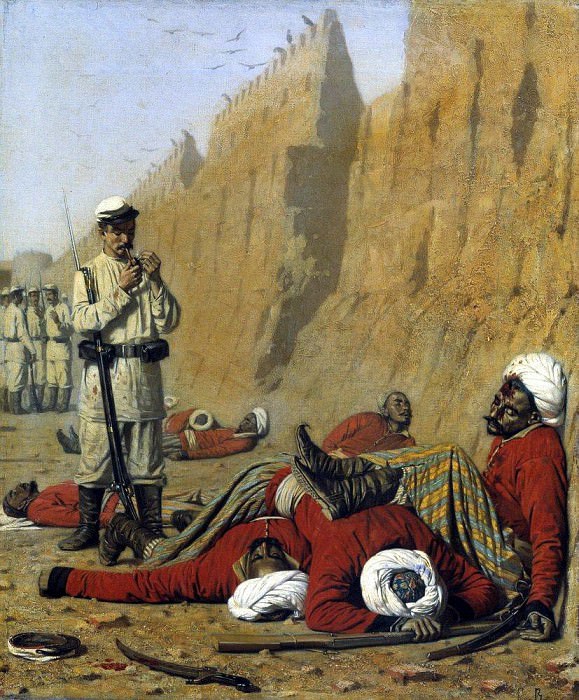After setbacks. 1868 Vasily Vereshchagin (1842-1904)
Vasily Vereshchagin – After setbacks. 1868
Edit attribution
Download full size: 827×1000 px (0,2 Mb)
Painter: Vasily Vereshchagin
Vasily Vereshchagin loved to travel, and almost all the time was on the road. During his life he managed to visit several dozen countries. Among them are the United States, China, and many regions of the Caucasus and Transcaucasia. However, a special role in his work was played by two trips to Turkestan. It was the memories of the terrible war in Samarkand and became food for the brain and inspiration for the artist’s work.
Description of Vasily Vereshchagin’s painting "After Failure
Vasily Vereshchagin loved to travel, and almost all the time was on the road. During his life he managed to visit several dozen countries. Among them are the United States, China, and many regions of the Caucasus and Transcaucasia. However, a special role in his work was played by two trips to Turkestan.
It was the memories of the terrible war in Samarkand and became food for the brain and inspiration for the artist’s work. Between 1867 and 1870, he made his first visit to the country. That’s when the masterpiece "After Failure", dated 1868, came out from under the artist’s brush. The appearance of the painting coincided with the aggravation of the military-political situation in the region. That was the time of large-scale military operations aimed at annexing the territories of Asia to Russia. It became the reason for the struggle of local residents against Russian soldiers.
To fully cover the events of the time, Vereshchagin wrote a second paired painting "After Luck" to the canvas "After Failure". Both masterpieces described the events of the "holy war" from both sides. The works displayed the brutal and bloody side of the battle for each belligerent state.
The plot is uncomplicated but eloquent. A fortress wall is depicted in the background. Ravens are hovering above it, a symbolic image of death. In the foreground are the dead bodies of the Bukhara people. Next to them, Russian warriors are serenely conversing. One of them smokes unhurriedly next to the dead.
The painting condemns this callous behavior of the soldiers, completely denying the usual image of noble warriors-victors. The painting contains a mute reproach to the bloodshed and the silent serenity of the murderers.
Кому понравилось
Пожалуйста, подождите
На эту операцию может потребоваться несколько секунд.
Информация появится в новом окне,
если открытие новых окон не запрещено в настройках вашего браузера.
You need to login
Для работы с коллекциями – пожалуйста, войдите в аккаунт (open in new window).




















You cannot comment Why?
The painting depicts a scene of aftermath following a conflict, likely a battle, against a backdrop of a formidable, sun-baked fortification. In the foreground, several figures in red uniforms with white turbans lie on the ground, some appearing deceased and others wounded. Their bodies are sprawled amidst fallen weapons, including rifles and a curved dagger, highlighting the violence of the preceding events. A single standing figure, also in military attire but with a distinct white cap, calmly lights a pipe while leaning against a rifle. In the mid-ground, a line of soldiers in lighter uniforms stand in formation, appearing to be reinforcements or survivors. Overhead, birds circle a high, crenellated wall, adding a somber and desolate atmosphere to the scene.
The subtexts of this painting are multifaceted, offering commentary on the nature of war and empire.